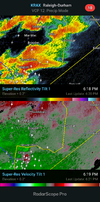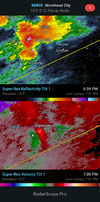National Weather Service Raleigh NC
337 PM EDT Thu Apr 7 2022
NCZ008>010-072015-
Vance NC-Warren NC-Granville NC-
337 PM EDT Thu Apr 7 2022
...A strong thunderstorm will impact portions of Vance, northwestern
Warren and northeastern Granville Counties through 415 PM EDT...
At 336 PM EDT, Doppler radar was tracking a strong thunderstorm 9
miles north of Henderson, moving northeast at 45 mph.
HAZARD...Winds in excess of 40 mph and half inch hail.
SOURCE...Radar indicated.
IMPACT...Gusty winds could knock down tree limbs and blow around
unsecured objects. Minor damage to outdoor objects is
possible.
Locations impacted include...
Henderson, Oxford, Norlina, Kittrell, Stovall, Middleburg, Gillburg,
Steele Creek Marina & Campground, Kerr Lake and South Henderson.
337 PM EDT Thu Apr 7 2022
NCZ008>010-072015-
Vance NC-Warren NC-Granville NC-
337 PM EDT Thu Apr 7 2022
...A strong thunderstorm will impact portions of Vance, northwestern
Warren and northeastern Granville Counties through 415 PM EDT...
At 336 PM EDT, Doppler radar was tracking a strong thunderstorm 9
miles north of Henderson, moving northeast at 45 mph.
HAZARD...Winds in excess of 40 mph and half inch hail.
SOURCE...Radar indicated.
IMPACT...Gusty winds could knock down tree limbs and blow around
unsecured objects. Minor damage to outdoor objects is
possible.
Locations impacted include...
Henderson, Oxford, Norlina, Kittrell, Stovall, Middleburg, Gillburg,
Steele Creek Marina & Campground, Kerr Lake and South Henderson.




